The Armenian Genocide and earlier massacres are defining aspects of the contemporary Armenian heritage and identity. By far the dominant literary mode of expression about the Armenian Genocide are those of survivor memoirs and historical novels, with the latter often greatly influenced by extended family histories. It is the literature of bearing witness and a key goal is to remember the Great Crime/Catastrophe.
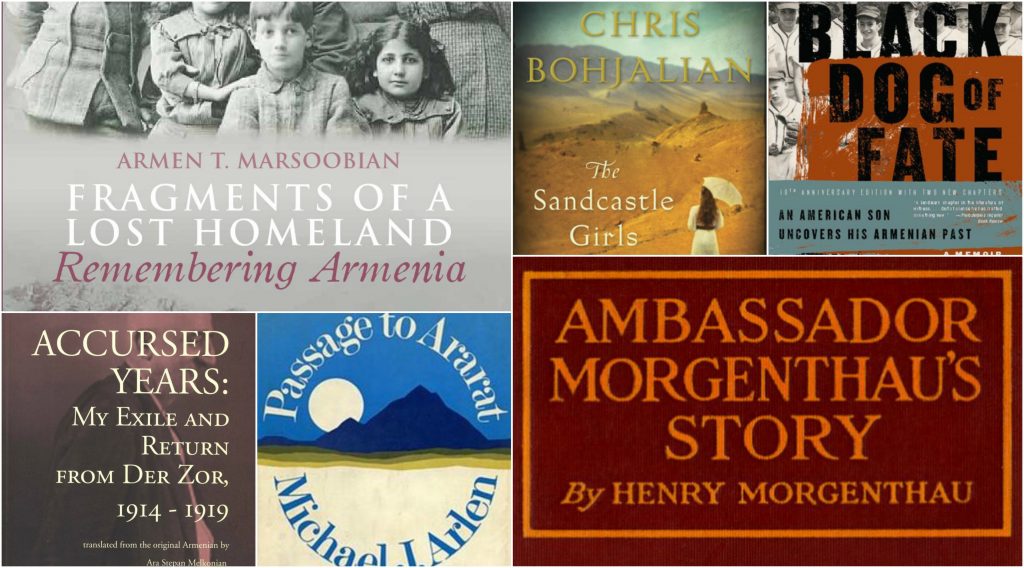
The Armenian Genocide and earlier massacres are defining aspects of the contemporary Armenian heritage and identity.
Lorne Shirinianís
Survivor Memoirs of the Armenian Genocide (1999) was an early overview summary booklet of some of these works in English. More recently, pioneering academic volumes by Rubina Peroomian
The Armenian Genocide in Literature: Perceptions of Those Who Lived Through the Years of Calamity (2012) and
The Armenian Genocide in Literature: The Second Generation Responds (2015), with a forthcoming volume on the third generation in progress, provide a comprehensive account of Armenian writings on the massacres and 1915 genocide
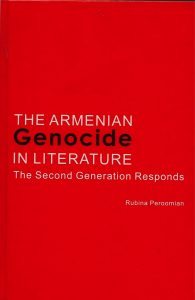
The cover of
The Armenian Genocide in Literature: The Second Generation Responds
The first generation of genocide survivor authors had endured traumatic events and struggled to describe their horrific experiences. Many had little or no previous experience at literary writing, but given the terrible magnitude of what they had endured and witnessed, they felt an historic duty to pen personal accounts of what happened. Their primary audiences were immediate family members and later generations of Armenians.
The authors not only sought to tell the family history to the next generation and the outside public, but also to combat ongoing Turkish denial and injustice. Many of these books were self-published. Sometimes the manuscripts remained in draft form, often untranslated into English, until significantly later. Even now, we do not have a full compendium list of these works in English, let alone Armenian and other languages. Nevertheless, these early accounts provided an important foundation and inspiration for later generations growing up in the diaspora. They also ensured that the mass deportations and massacres did not become a ďforgotten genocideĒ.
Amongst the memoirs printed in English, two of the most famous were penned early on within several years of each other in the United States. Genocide survivor Arshaluys Martikian/Aurora Mardiganianís autobiography
Ravished Armenia (1918) was serialized in newspapers, then was turned into a popular book, and shortly thereafter became, what was probably, Hollywoodís first genocide film. Sadly, the film only exists in fragments and in script form.
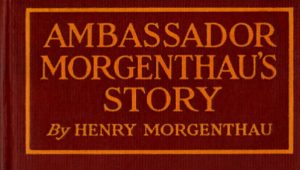
American Ambassador to the Ottoman Empire, Henry Morgenthauís witness memoir
Ambassador Morgenthauís Story (1918)
American Ambassador to the Ottoman Empire, Henry Morgenthauís witness memoir
Ambassador Morgenthauís Story (1918), also drawing upon consular reports, provided detailed accounts of the Turkish governmentís mass deportations and killings of the Armenians. It also noted American efforts to stop the Young Turk perpetrators and provide urgent assistance to the victims. Grigoris Balakianís
Armenian Golgotha: A Memoir of the Armenian Genocide (2009) is an epic 500-page account by a distinguished Armenian clergyman. While it was first published in Armenian in two volumes in 1922 and 1959, it was not available in English for almost nine decades. The lack of early translation into English was and remains a major challenge, preventing many memoirs from achieving wider readership sooner.
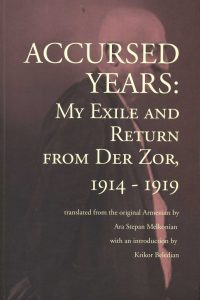
The cover of Yervant Odianís
Accursed Years: My Exile and Return From Der Zor, 1914-1919
Amongst the memoirs available in English (listed by year of publication) are the following: clergyman Abraham H. Hartunianís
Neither To Laugh Nor to Weep: A Memoir of the Armenian Genocide (1968). Other memoirs include Kerop Bedoukianís
The Urchin: An Armenian Escape (1978) reprinted as
Some of Us Survived (1979), Alice Muggerditchian Shipleyís
We Walked, Then We Ran (1983), John (Hovhannes) Minassianís
Many Hills to Climb (1986), Hovhannes Mugrditchianís
To Armenians with Love (1986), Bertha Nakshian Ketchianís
In the Shadow of the Fortress: The Genocide Remembered (1988), John Yervantís (Yervant Kouyoumjian)
Needles, Thread and Button (1988), Ramela Martinís Our of Darkness (1989), Ephraim K. Jernazianís
Judgment Unto Truth: Witnessing the Armenian Genocide (1990), Armen Anushís
Passage Through Hell: A Memoir (2007), Shahen Derderianís
Death March (2008), Yervant Odianís
Accursed Years: My Exile and Return From Der Zor, 1914-1919 (2009), and Karnig Panianís
Goodbye, Antoura: A Memoir of the Armenian Genocide (2015).
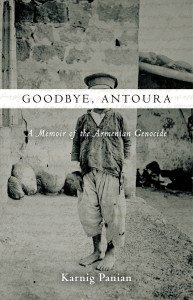
The cover of
Goodbye, Antoura
The next generationsí writings were influenced by not only the 1915 genocide, but also their lives and experiences with their dual identities of emigre/immigrant family members in the global Diaspora. Their writings reveal that the wounds of genocide are deep and span several generations. The Diaspora writers described their alienation and profound separation from their ancestral homeland and from the many dead and displaced kin. Existential angst was a frequent and important theme.
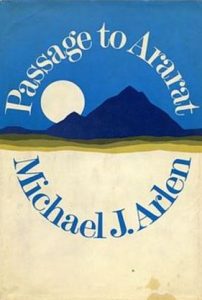
The cover of
Michael Arlenís Passage to Ararat
From the 1960ís onwards, particularly following the 50th anniversary in 1965 of the Armenian Genocide, awareness and writing on the subject increased. A growing number of Diaspora writers sought to explore their roots and tell of their fellow Armeniansí tragic fate. The Greek-American Elia Kazanís
America America (1961) was a novel, screenplay, and then acclaimed epic film that describes the terrible plight of the Christian Armenian and Greek minorities in the Ottoman Empire. Peter Sourianís novel
The Gate (1965) also focuses on the Armenian Genocide. Michael Arlenís
Passage to Ararat (1975) addresses the challenges of assimilation, the quest for identity and tells of an odyssey of ethnic self-discovery. Peter Najarian’s
Voyages (1971) and
Daughters of Memory (1986) also recounts the Armenian story and the quest for identity in the Diaspora. David Kherdian outlines his mother’s life in
The Road from Home: The Story of an Armenian Girl (1979). Carol Edgarian’s
Rise the Euphrates (1994) shows that later generations of American-born Armenians continue to suffer from the lasting effects of genocide. In
Vergeen: A Survivor of the Armenian Genocide (1996), Mae Derdarian confronts Turkish revisionist denial of the genocide. Dora Sakayanís edited and translated her grandfatherís journal in
An Armenian Doctor in Turkey: Garabed Hatcherian: My Smyrna Ordeal of 1922 (1997). Peter Balakian’s award-winning and highly influential
Black Dog of Fate (1998) outlines a complex existential journey that commences in the comfortable suburbs of America, but gradually reveals a past history of increasing layers of violence and suffering of the Ottoman Armenian extended family. It resembles the descent into deeper levels of hell.
The dawn of the 21st century saw a continuation in literary writings on the Armenian Genocide. The potential list is substantial. Amongst the volumes are the following: Agop Hacikyanís
A Summer without Dawn (2000) recounts his growing awareness of the magnitude of the genocide. The novel
Lines in the Sand: Love, Tragedy, and the Armenian Genocide (2001) is by the genocide documentary film-maker Thomas Ohanian. Vickie Smith Foston’s
Victoria’s Secret: A Conspiracy of Silence (2001) describes how her Armenian ancestors fled the Hamidian massacres of the 1890ís.
Three Apples Fell from Heaven (2001) is inspired by Micheline Aharonian Marcom’s discovery of her grandmother’s life story. Theodore Kharpertianís
Hagop: An Armenian Genocide Survivorís Journey to Freedom (2003) is an account of his fatherís ordeals. Sara Chitjian transcribed, translated and published her fatherís drafts of his memoirs in
A Hairís Breath From Death: The Memoirs of Hampartzoum Mardiros Chitjian (2003). Antonia Arslanís
Skylark Farm (2004) is a historical novel about her familyís suffering during the genocide and was later turned into the film ďThe Lark FarmĒ. Henri Verneuilís (Ashod Malikian)
Mayrig (2006) is a historical novel about an Armenian familyís difficult conditions living in forced exile. The book was later turned into a film. Margaret Adjemian Ahmertís
The Knock at the Door (2007) is the story of the survival of Margaretís mother amidst the mass deportations and massacres. Marcella Polainís
The Edge of the World (2007) is a ďfictionalized autobiographyĒ that describes the fragmentation of an Armenian family by the genocide and forced exile.
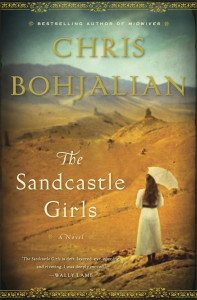
The cover of Chris Bohjalianís The Sandcastle Girls
In the lead up to 2015, the 100th memorial year of the genocide, an increased number of volumes appeared from another generation of Diaspora writers. Chris Bohjalianís
The Sandcastle Girls (2012) is a romantic novel set amidst the genocide. Dana Walrathís
Like Water on a Stone (2014), echoing a Greek tragedyís epic poem, tells a harrowing literary tale of two children surviving the ordeals of the genocide. Drawing upon his relativesí earlier attempts, Armen T. Marsoobian pens a family history in
Fragments of a Lost Homeland: Remembering Armenia (2015). Maral Boyadjianís
As the Poppies Bloomed (2015) is a romantic novel set amidst the genocide. Dawn Anahid MacKeenís
The Hundred Year Walk: An Armenian Odyssey (2016) involves the intertwined autobiographies of a genocide survivor and that of his granddaughter, who retraces his perilous journey a century later.
The different generations of memoirs and historical novels on the Armenian Genocide reveal the ongoing suffering of Armenians throughout the world. The genocide has become a key defining part of the Armenian identity. As such, Armenian authors, even a century later, feel compelled to write accounts of the Armenian Genocide and, in so doing, ensure that it does not become a ďforgotten genocideĒ.
The Armenian Genocide and earlier massacres are defining aspects of the contemporary Armenian heritage and identity. By far the dominant literary mode of expression about the Armenian Genocide are those of survivor memoirs and historical novels, with the latter often greatly influenced by extended family histories. It is the literature of bearing witness and a key goal is to remember the Great Crime/Catastrophe. The Armenian Genocide and earlier massacres are defining aspects of the contemporary Armenian heritage and identity. Lorne Shirinianís Survivor Memoirs of the Armenian Genocide (1999) was an early overview summary booklet of some of these works in English. More recently, pioneering academic volumes by Rubina Peroomian The Armenian Genocide in Literature: Perceptions of Those Who Lived Through the Years of Calamity (2012) and The Armenian Genocide in Literature: The Second Generation Responds (2015), with a forthcoming volume on the third generation in progress, provide a comprehensive account of Armenian writings on the massacres and 1915 genocide The cover of The Armenian Genocide in Literature: The Second Generation Responds The first generation of genocide survivor authors had endured traumatic events and struggled to describe their horrific experiences. Many had little or no previous experience at literary writing, but [...]
The Armenian Genocide and earlier massacres are defining aspects of the contemporary Armenian heritage and identity. By far the dominant literary mode of expression about the Armenian Genocide are those of survivor memoirs and historical novels, with the latter often greatly influenced by extended family histories. It is the literature of bearing witness and a key goal is to remember the Great Crime/Catastrophe. The Armenian Genocide and earlier massacres are defining aspects of the contemporary Armenian heritage and identity. Lorne Shirinianís Survivor Memoirs of the Armenian Genocide (1999) was an early overview summary booklet of some of these works in English. More recently, pioneering academic volumes by Rubina Peroomian The Armenian Genocide in Literature: Perceptions of Those Who Lived Through the Years of Calamity (2012) and The Armenian Genocide in Literature: The Second Generation Responds (2015), with a forthcoming volume on the third generation in progress, provide a comprehensive account of Armenian writings on the massacres and 1915 genocide The cover of The Armenian Genocide in Literature: The Second Generation Responds The first generation of genocide survivor authors had endured traumatic events and struggled to describe their horrific experiences. Many had little or no previous experience at literary writing, but [...]
[img][/img]
More...